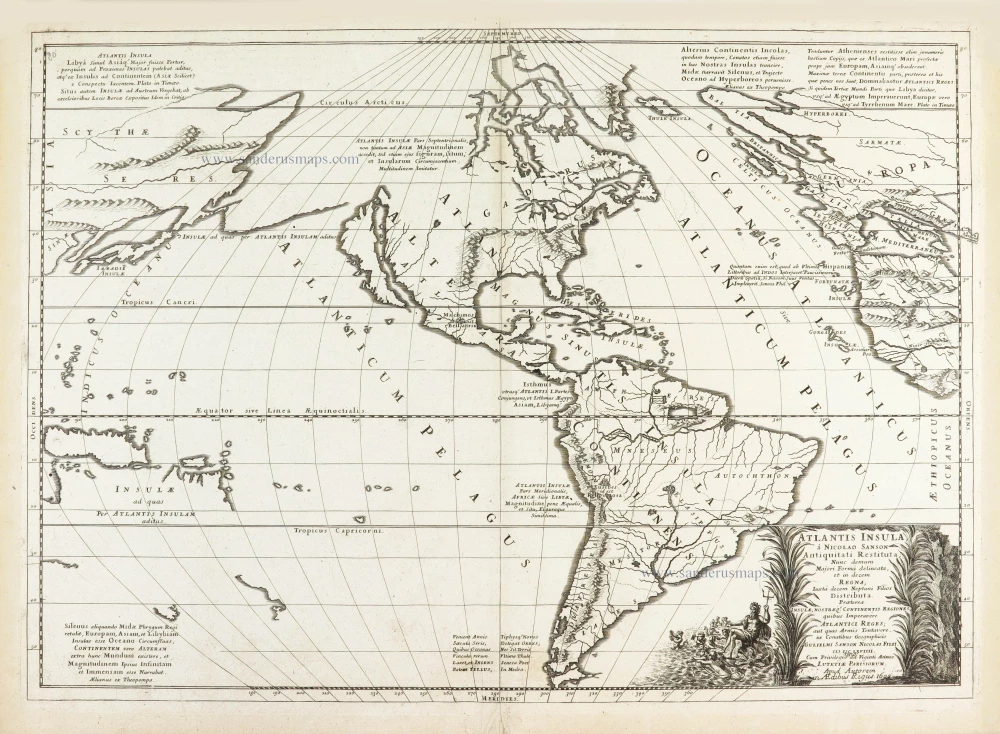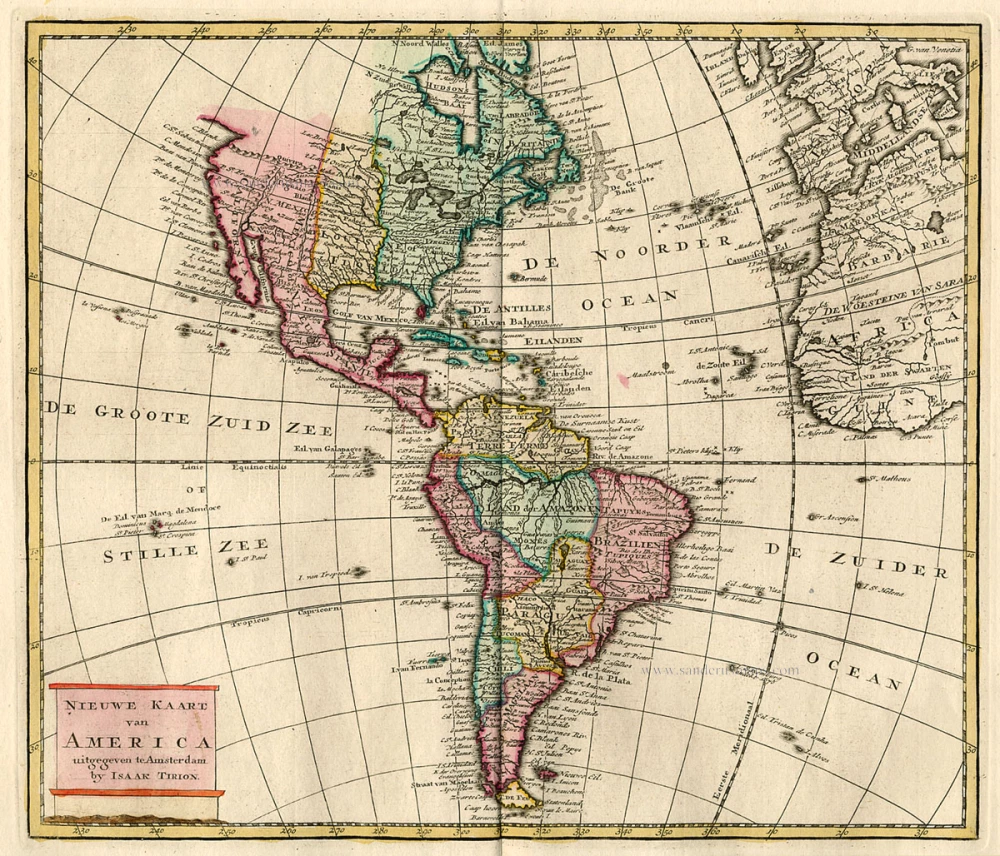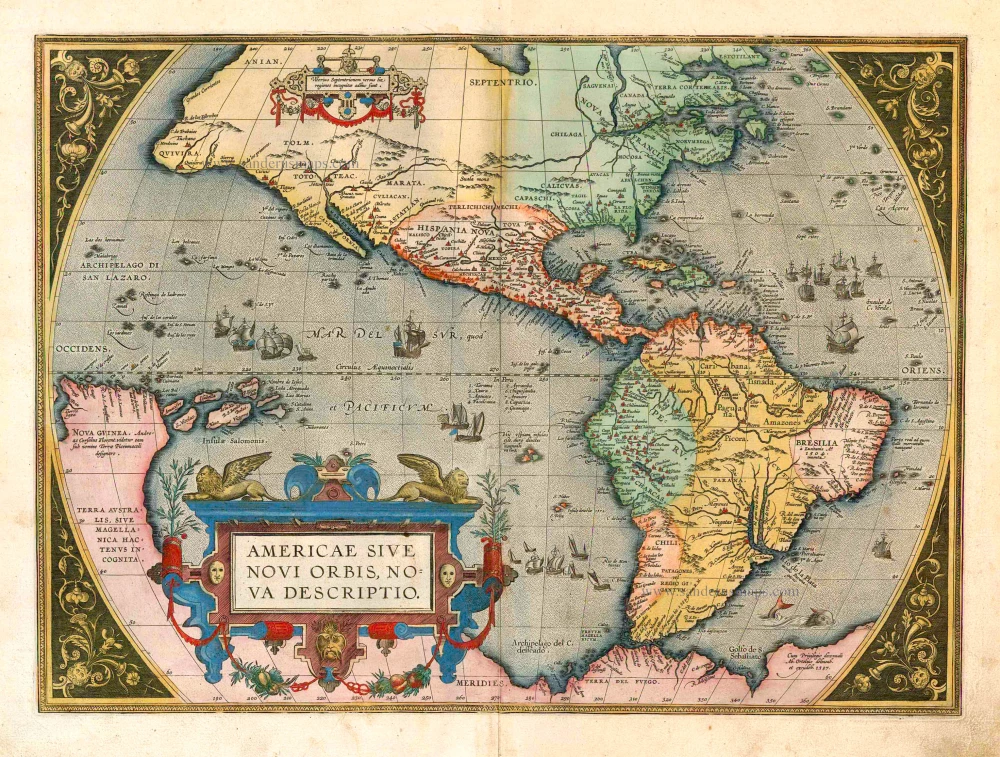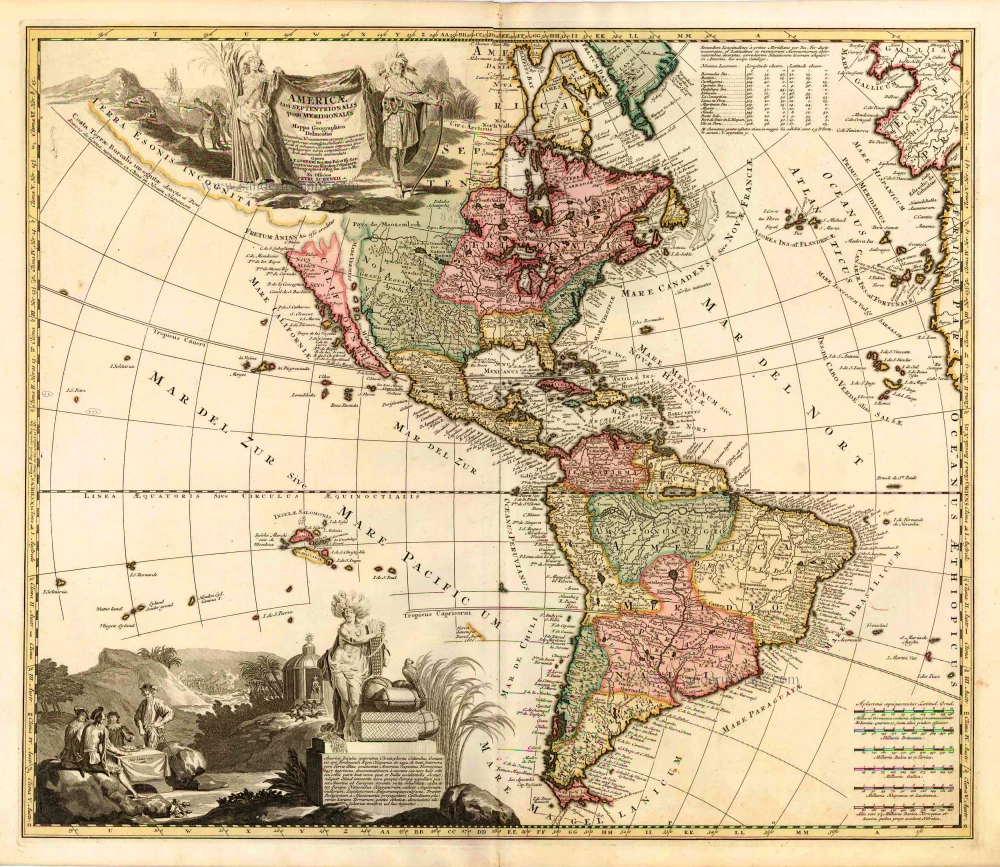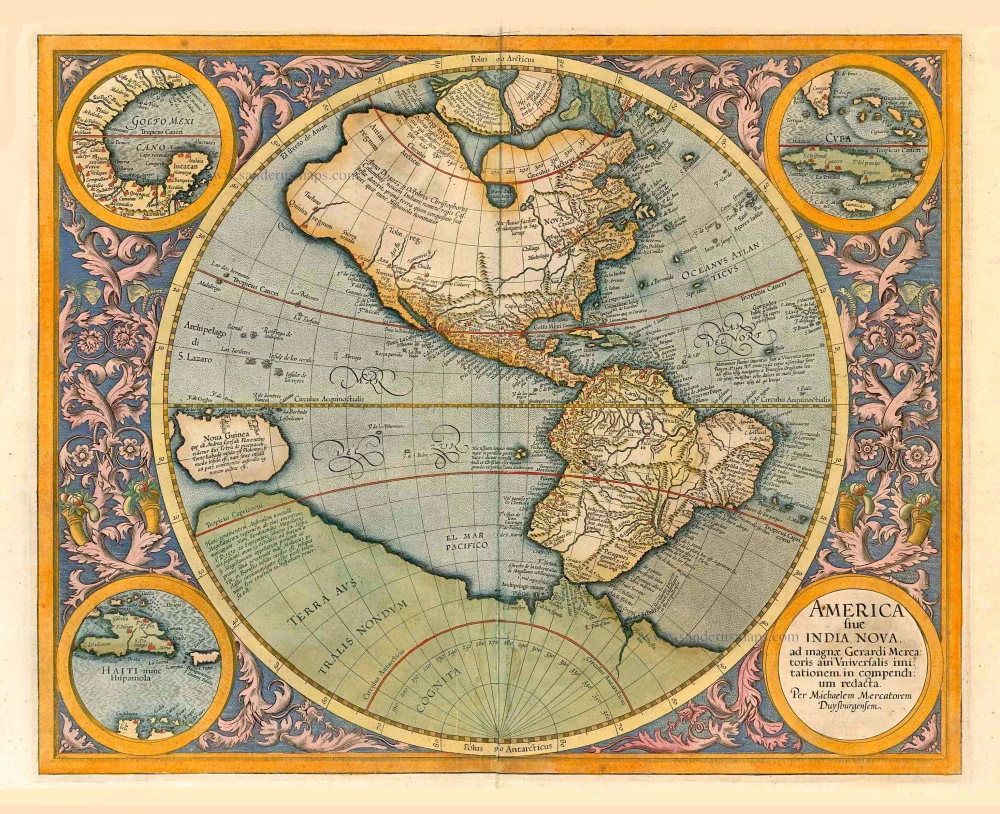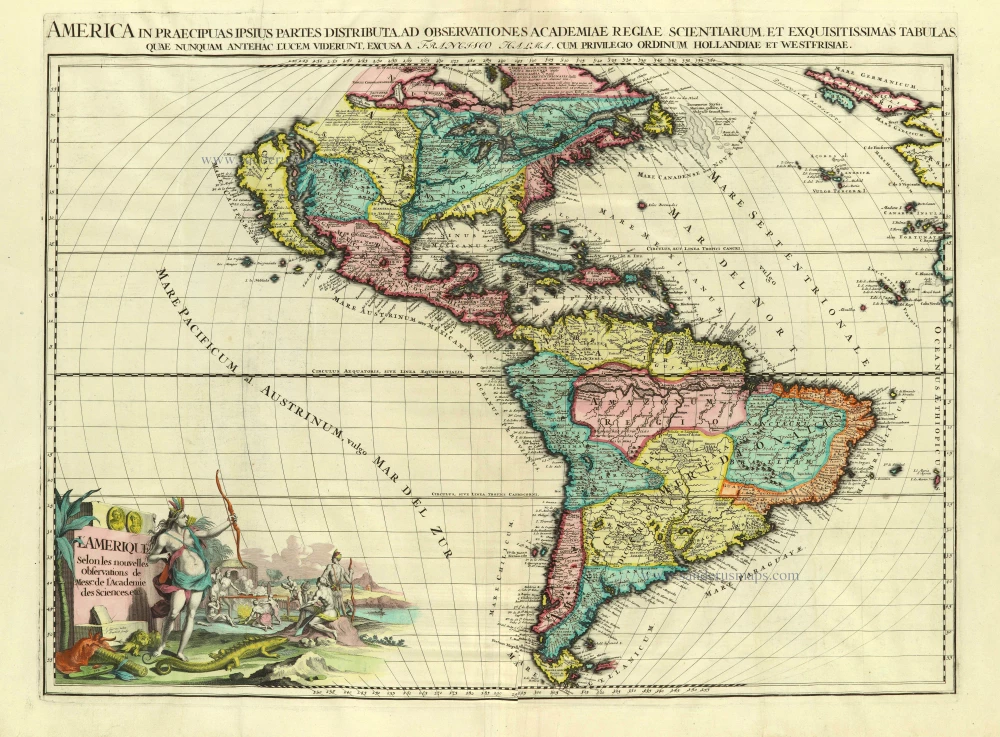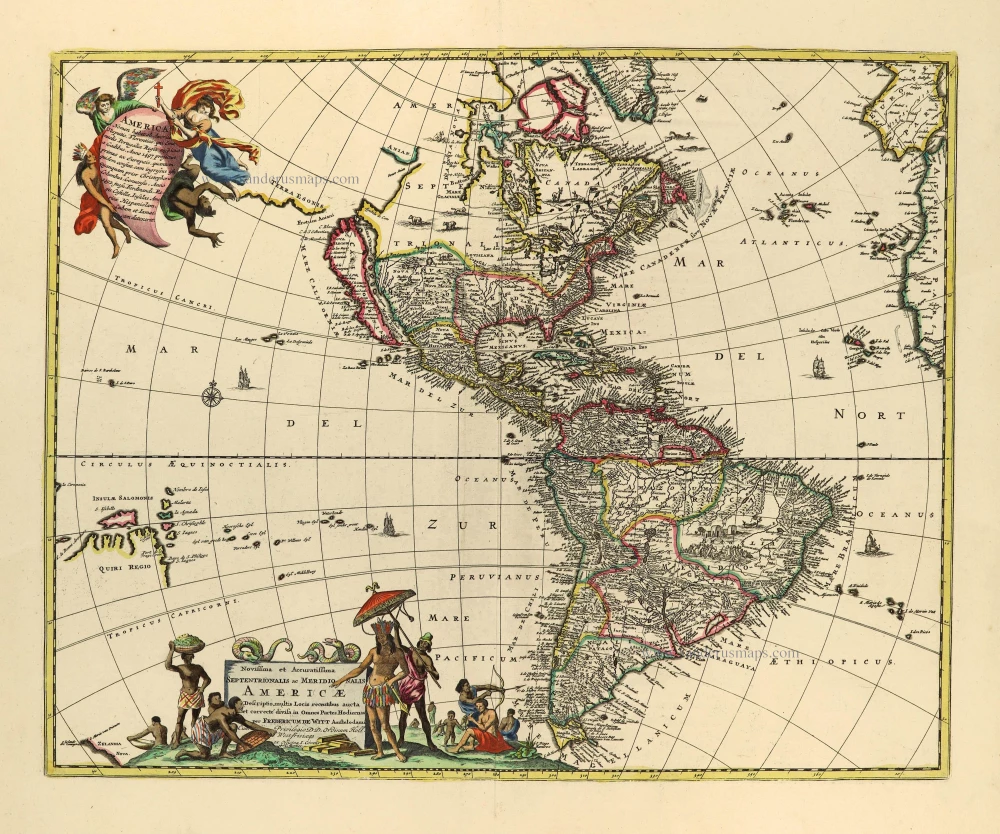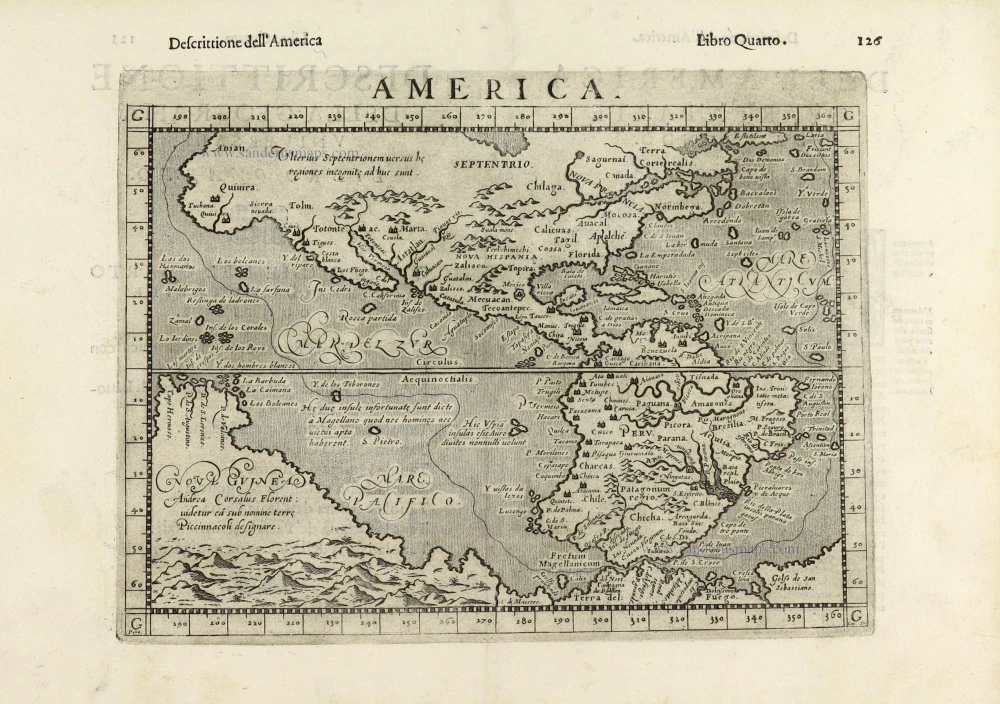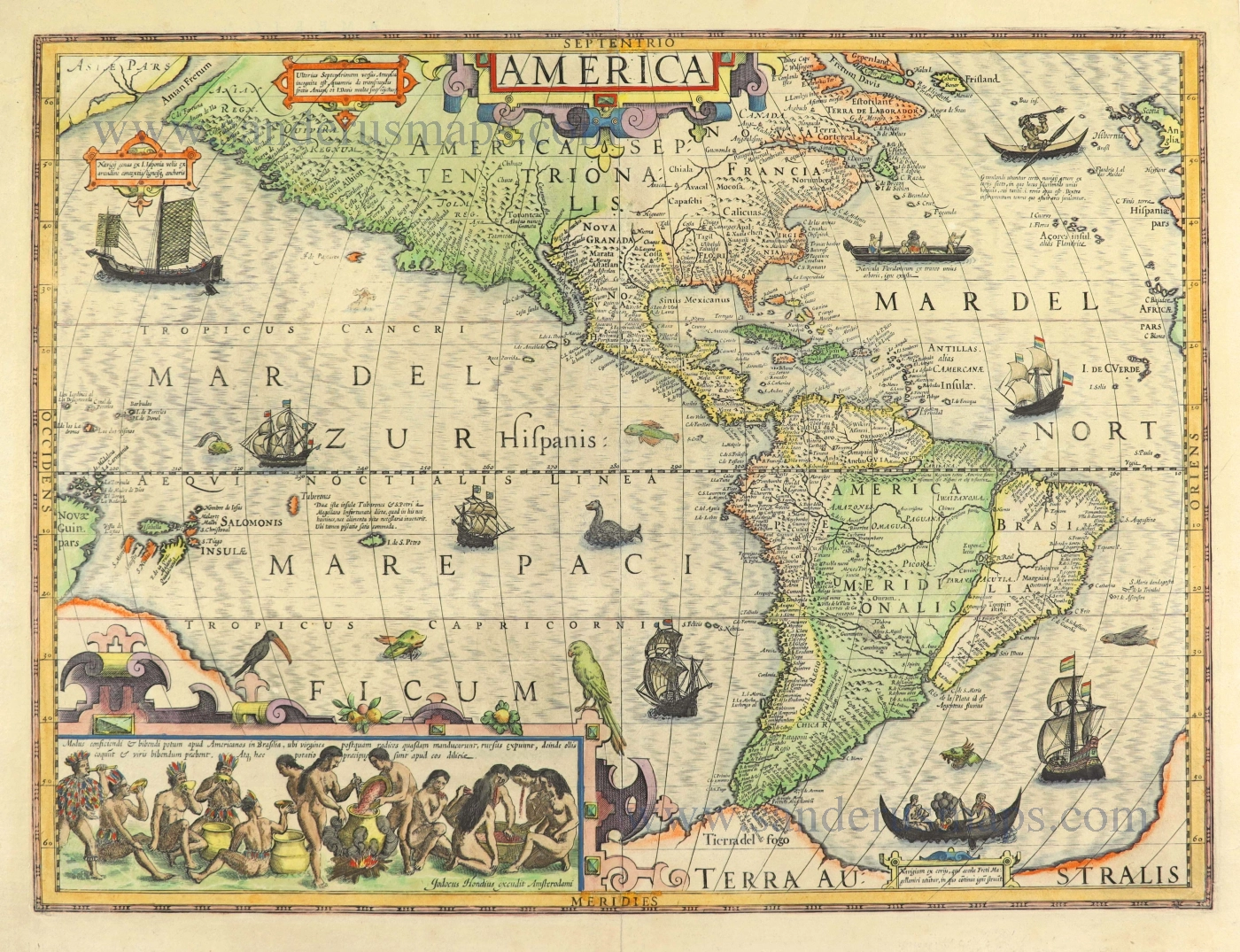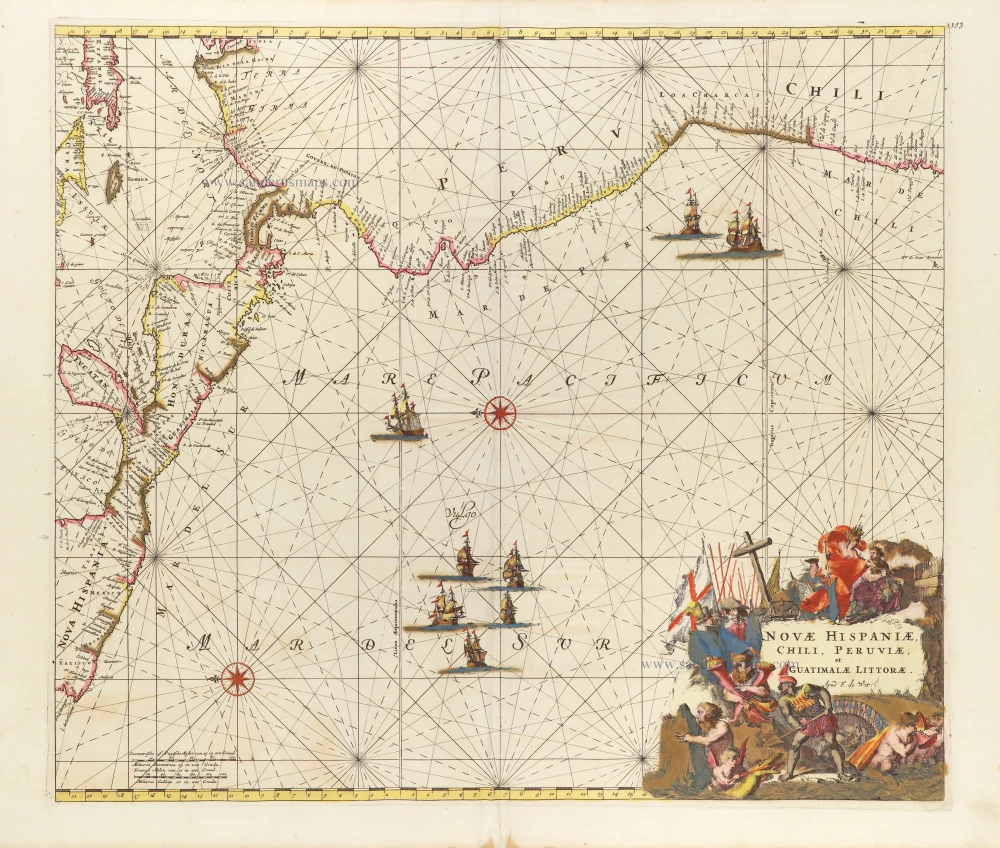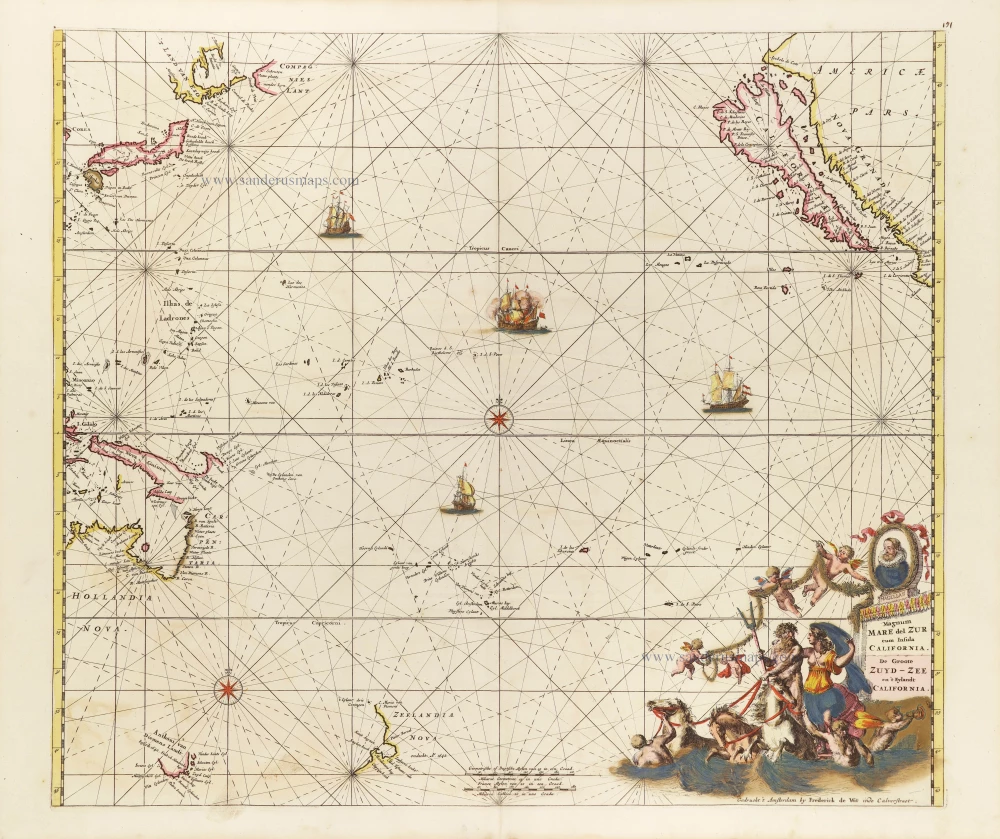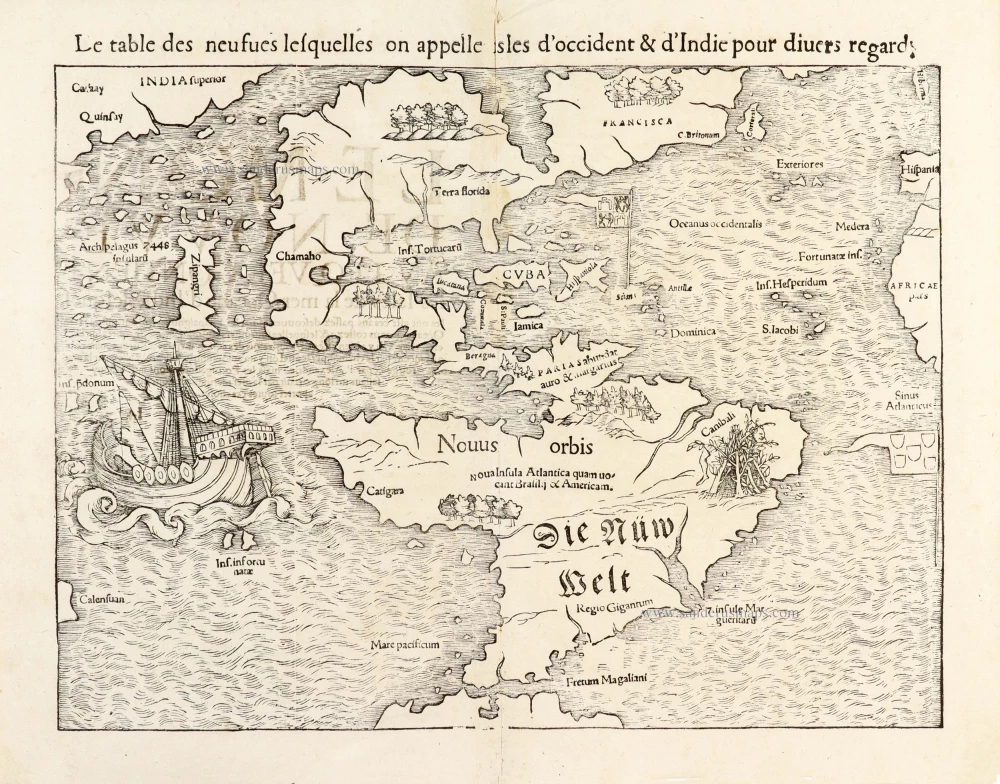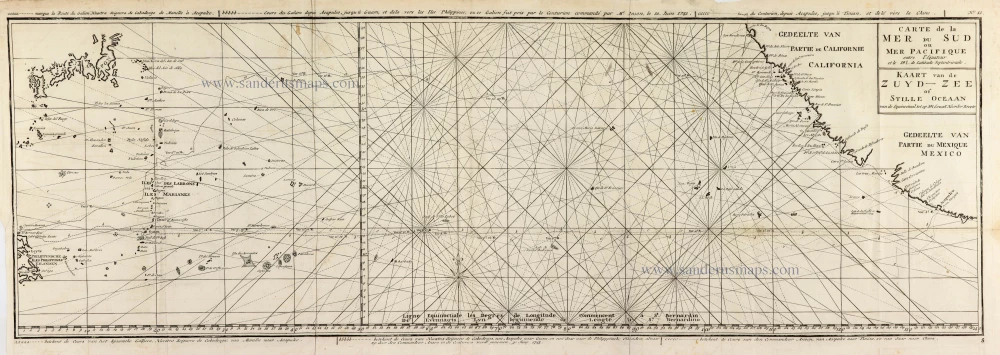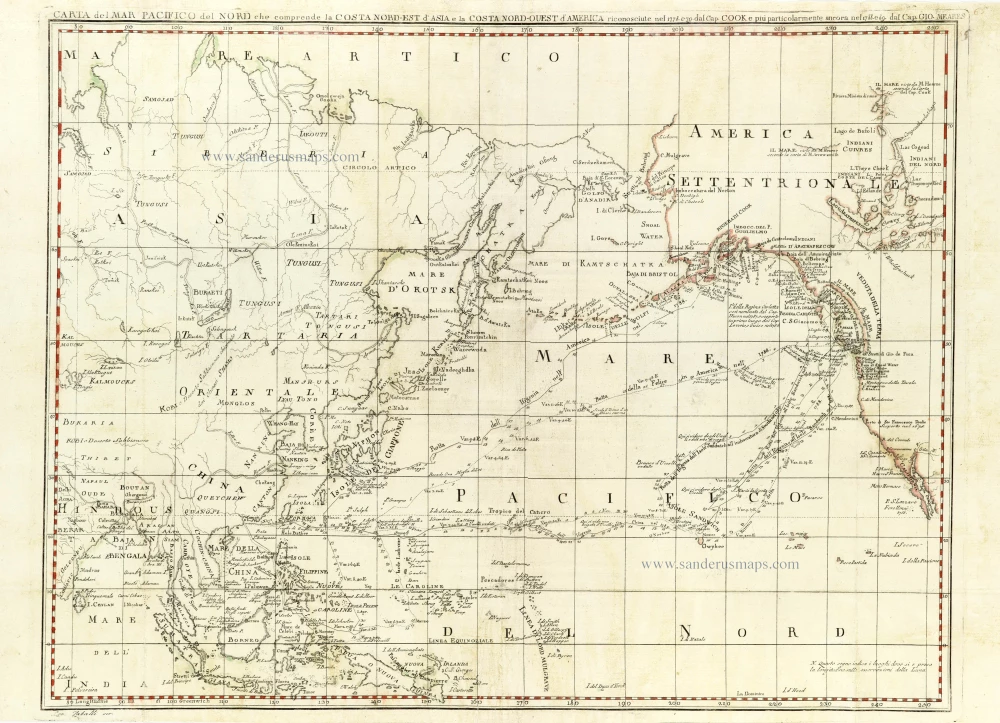California as an island
The Americas by Guillaume Sanson. 1692
An attempt by Sanson to show ancient North and South America in a contemporary outline (Tooley).
America is called 'The Island of Atlantis' and is divided into regions named after the sons of Neptune.
The map shows fragments of the Australian continent, interpreting New World geography in the light of the narratives and opinions of classical authors, especially Plato. His Timeus and Critias are quoted in several places on the map, suggesting that the Atlanteans had, in ancient times, invaded Europe. Seneca is quoted on the future existence of the New World and its distance from the Old, and Claudius Aelianus on the size, etc., of the other world.
SANSON FAMILY
Nicolas Sanson (1600-1667) - Guillaume Sanson (1633-1703) - Pierre Moullart-Sanson (? -1730)
Originally from Abbeville, Nicolas I Sanson showed a keen interest in historical geography. He was still very young; he published a map of ancient Gaul and two treatises, Britannia and Portus Itius on Abbeville and Boulogne's origins. His meeting with Melchior Tavernier was decisive: it prompted him to give up his duties as a military engineer in Picardy and devote himself to engraved cartography.
At the same time, Sanson had drawn up the outline of modern France. He got the help of Tavernier, who encouraged him to compete with the Dutch map publishers. Tavernier contacted other French cartographers whose works he published.
From 1643, N. Sanson obtained a privilege to publish a work personally, the Princes souverains de l'Italie. Then, in 1644 and 1645, he had his famous geographical tables printed, which significantly contributed to his fame. He also published a series of atlases in quarto of the four continents.
In 1648, N. Sanson associated himself with Mariette to publish atlases. From then on, specific maps bore his name and others Mariette's. N. Sanson and Mariette worked together for more than 20 years. After the death of N. Sanson, Mariette acquired the entire fund. Since Mariette only wanted to publish complete atlases, individual maps were no longer sold, and some army generals complained to the king.
The disagreement between the Sanson family and Pierre II Mariette culminated in 1671 when Guillaume Sanson took the case to court. There was no longer any question of collaboration: Guillaume Sanson started working for another publisher, Alexis-Hubert Jaillot.
The Sanson family faced financial difficulties, and in 1692, their cousin, Pierre Moullart-Sanson, bought the entire geographic fund from his uncles and aunt. Pierre Moullart-Sanson was the son of Françoise Sanson (third child of Nicolas) and Pierre Moullart. He restarted the publishing of Sanson's world atlas, and in 1704 he acquired a privilege for publishing all the works of Nicolas and Guillaume Sanson, which continued to be published until 1730.
Atlantis Insula.
Item Number: 28376 Authenticity Guarantee
Category: Antique maps > America > The Americas
Old, antique map of America, by Sanson Nicolas.
California is shown as an island.
Title: Atlantis Insula.
a Nicolao Sanson Antiquitati Restituta; Nunc demum Majori Forma Delineata, et in Decem Regna, Iuxta Decem Neptuni Filios Distributa.
Praeterea Insule, nostraeq. Continentis Regiones quibus Imperavere Atlantici Reges; aut quas Armis Tentavere.
ex Conatibus Geographicis Gulielmi Sanson Nicolai Filii.
MDCLVIIII.
Cum Privilegio dd Viginti Annos
Lutetiae Parisiorum.
Apud Autorem in Aedibus Regus 1690.
Date of the first edition: 1669.
Date of this map: 1692.
Date on map: 1690.
Copper engraving, printed on paper.
Map size: 400 x 560mm (15.75 x 22.05 inches).
Sheet size: 445 x 610mm (17.52 x 24.02 inches).
Verso: Blank.
Condition: Excellent.
Condition Rating: A+.
References: Burden, #405, state 3; McLaughlin, #46; Tooley (America), p. 124 #51; Pastoureau, Sanson V D [208]
From: Les tables et les cartes de la Geographie Ancienne et Nouvelle ou methode pour s'instruire avec facilité de la Geographie, et connoistre les empires, monarchies, royaumes, estats, republiques et peuples, tant anciens que nouveaux, de toutes les parties du monde en combien de regions particulieres ou provinces ils se subdivisent, et quelles en sont les villes les plus considerables. Par les Srs Sanson Geographes ordinaire du Roy. A Paris, chez l'autheur, aux Galleries du Louvre, 1692. Avec privilege pour vingt ans. (Pastoureau, Sanson V H 1692)
An attempt by Sanson to show ancient North and South America in a contemporary outline (Tooley).
America is called 'The Island of Atlantis' and is divided into regions named after the sons of Neptune.
The map shows fragments of the Australian continent, interpreting New World geography in the light of the narratives and opinions of classical authors, especially Plato. His Timeus and Critias are quoted in several places on the map, suggesting that the Atlanteans had, in ancient times, invaded Europe. Seneca is quoted on the future existence of the New World and its distance from the Old, and Claudius Aelianus on the size, etc., of the other world.
SANSON FAMILY
Nicolas Sanson (1600-1667) - Guillaume Sanson (1633-1703) - Pierre Moullart-Sanson (? -1730)
Originally from Abbeville, Nicolas I Sanson showed a keen interest in historical geography. He was still very young; he published a map of ancient Gaul and two treatises, Britannia and Portus Itius on Abbeville and Boulogne's origins. His meeting with Melchior Tavernier was decisive: it prompted him to give up his duties as a military engineer in Picardy and devote himself to engraved cartography.
At the same time, Sanson had drawn up the outline of modern France. He got the help of Tavernier, who encouraged him to compete with the Dutch map publishers. Tavernier contacted other French cartographers whose works he published.
From 1643, N. Sanson obtained a privilege to publish a work personally, the Princes souverains de l'Italie. Then, in 1644 and 1645, he had his famous geographical tables printed, which significantly contributed to his fame. He also published a series of atlases in quarto of the four continents.
In 1648, N. Sanson associated himself with Mariette to publish atlases. From then on, specific maps bore his name and others Mariette's. N. Sanson and Mariette worked together for more than 20 years. After the death of N. Sanson, Mariette acquired the entire fund. Since Mariette only wanted to publish complete atlases, individual maps were no longer sold, and some army generals complained to the king.
The disagreement between the Sanson family and Pierre II Mariette culminated in 1671 when Guillaume Sanson took the case to court. There was no longer any question of collaboration: Guillaume Sanson started working for another publisher, Alexis-Hubert Jaillot.
The Sanson family faced financial difficulties, and in 1692, their cousin, Pierre Moullart-Sanson, bought the entire geographic fund from his uncles and aunt. Pierre Moullart-Sanson was the son of Françoise Sanson (third child of Nicolas) and Pierre Moullart. He restarted the publishing of Sanson's world atlas, and in 1704 he acquired a privilege for publishing all the works of Nicolas and Guillaume Sanson, which continued to be published until 1730.

